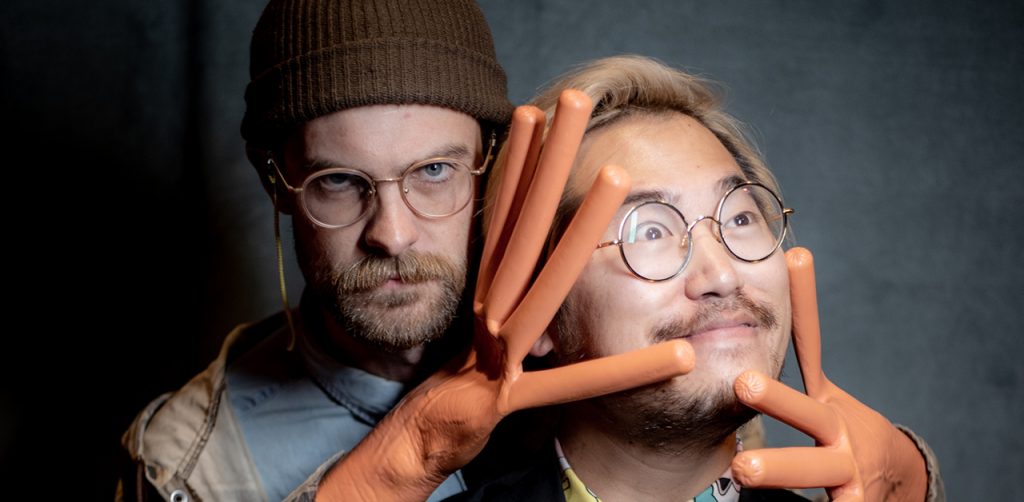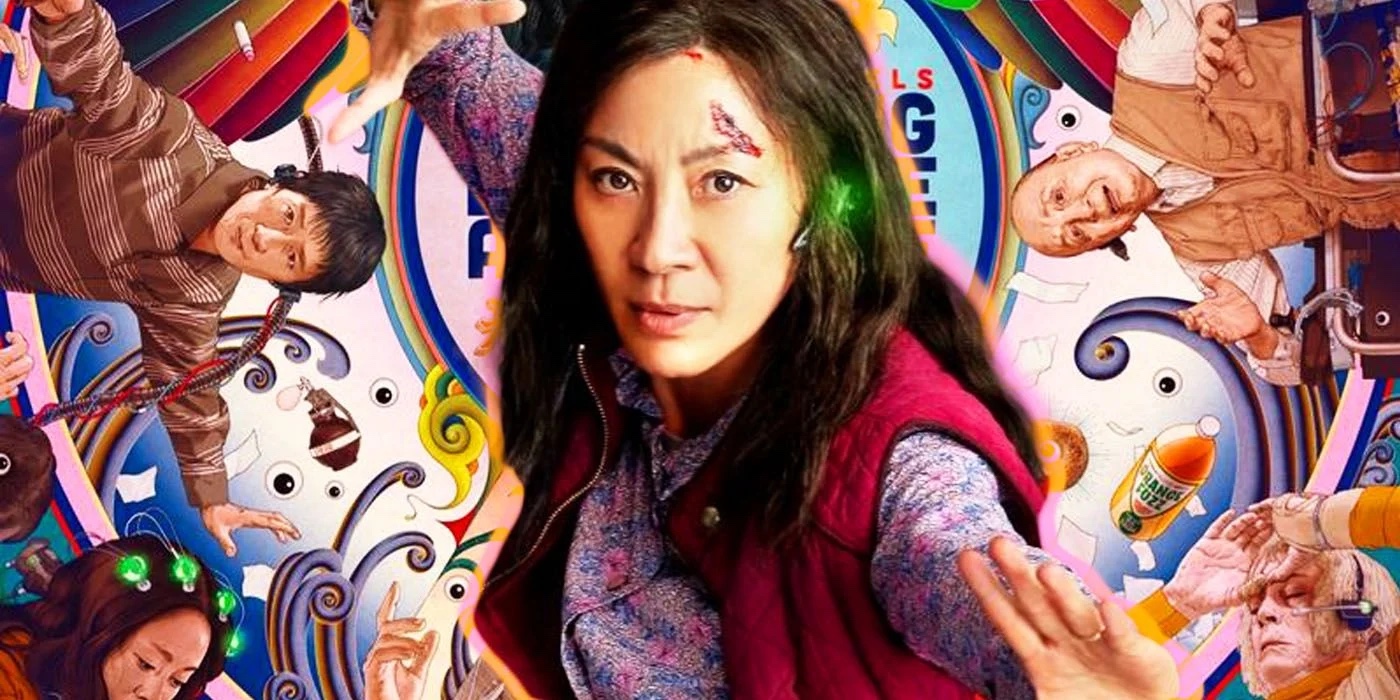Daniel Kwan and Daniel Scheinert (collectively known as Daniels) secured the highest praise from the Directors’ Guild of America (DGA) for their film Everything Everywhere All At Once. Not a bad achievement given that neither planned on becoming screenwriters after college. Kwan cut his storytelling teeth in animation thinking this would lead to a career in motion graphics. Scheinert was more of a generalist after film school – the ultimate hyphenate – shorthand for a jack of all trades – or Daniel of all trades. He filmed, he cut, he animated, he directed, he sliced he diced, he cheered on his colleague and everything in between. He considered himself a multi-purpose cinematic tool. The term “writer” was conspicuously absent from both their resumés. Until they produced a music video which put Daniels on the map. The concept and rapid image change of this form informed their writing.
It was the collaborative nature of screenwriting that formed the basis of Daniels. As successful music video directors bursting with creative ideas, their managers offered them a number of movie scripts to potentially direct. None of them resonated with them, so they decided to write their own. Their first outing into the feature film landscape was the head-scratching, flatulating Swiss Army Man which delighted, confused, scared, and excited their audience – all at once.
Daniels are still trying to perfect their writing collaboration and their brand of weirdness. Scheinert’s writing process includes watching, reading, journaling and writing down ideas as soon as they come to him. Then he’d convene with Kwan to discuss their work. “We’re active creators,” declares Kwan. They move as they create poetry – bouncing, rolling, skating, kicking balls…
Daniels also made a number of interactive short films which led them to the idea of multiverse storytelling – the first is an interactive love story called Possibilia.
Kwan references his dancing in the music video Turned Down For What. “I looked at my identity as an Asian-American man in a hip-hop video.”
It All Began With An Idea A Long Time Ago
The concept for Anywhere Everywhere All At Once began around 2010. Once Daniels settled down to sort, contain and order their fragmented thoughts, they considered “the ambition” of their structure so it didn’t spill into too many directions. So they reduced the number of ideas by one hundred.
Everything Everywhere All At Once is basically a generational immigrant family story set in a laundromat; one that easily lends itself to a standard hero’s journey format. It’s a story of love and hope. Hopes fulfilled and hopes dashed. It is a cauldron of contradictions and confusion and reconciling them. They all had to be threaded into some kind of recognizably tangible narrative – or not.
Then, Daniels had to figure out how to tell their shape-shifting story through a multiverse structure where the whole story falls apart and is rebuilt in scene after scene. There is a strange form in this formlessness. It’s not as random as you think.
At some point Kwan even challenges the notion of a hero in traditional storytelling. Everyone’s a hero in some universe at a point in time. “It was our way of fighting against all the rules of screenwriting,” he adds. Yeah, sock it the man! We’re rebels!
Traditional storytelling is one where characters make choices to bring them to their end goal. That’s what screenwriting students learn in film school.

Daniel Scheitert & Daniel Kwan (Daniels) Photo by Rich Fury/ Getty Images for SXSW
A multiverse format dilutes that template because they make multiple choices so nothing really matters. How nihilistic! Daniels imposed their philosophy of life into a multiverse structure that makes their film so engaging. Character is discovery and every character is in a constant state of exploration.
Daniels focus on the birth and death model of character by destroying them and allowing them to rebuild their lives in alternate universes.
Other themes they touch on include optimism, truth, identity, infinity, cosmic existentialism, absurdism, and other -isms. Everything examines the Theory of Everything through a range of theories. On an emotional note, the movie touches on real themes of trauma, rejection, loneliness and depression.
Anti-story. Anti-structure
The maverick “anti-structure” filmmakers are aware that personal experience is a great first step into writing a screenplay. Kwan focused on growing up as a Chinese-American to immigrant parents. Scheinert tapped into his love of kung-fu movies, hence the multiples Jackie Chan high-kicks in Everything Everywhere All At Once. Many scenes open in deep action like The Matrix. Alpha Waymond (Ke Huy Quan) is ostensibly the Morpheus of the film.
The multiverse format is the perfect way to explore the immigrant story – What if they stay in their new homes or what if they returned? “It’s a story of parallel paths,” adds Kwan. “How would each person live in each of these universes?” This relates not only to the immigrants themselves, but to their children’s lives growing up as first generation Americans. How would they thrive?
The multiverse was not only the most appropriate way to describe the “what ifs” in the immigrant experience, but it also catered to Daniels’ love of “pop science” from their music video days. “We would talk about Quantum Physics, Astrophysics or A.I.,” recalls Scheinert.
Evelyn’s (Michelle Yeoh) immigrant family is the grounding for the the movie. “It’s a portrait of a family in chaos,” states Kwan. To reinforce their distress, the story is trilingual – it contains English, Cantonese, and Mandarin dialogue and required three translators.
The locale of the Chinese laundromat was a fixture in Kwan’s specific immigrant culture. Aside from bringing back childhood memories for Kwan of his grandfather being a career Laundromat Owner-In-Chief as an expression of the Great American Dream, he relished the metaphor of washers and dryers turning everyone’s life around. It’s a wink to the philosophical studs on which the story is built. “If you go through someone’s laundry you really get to know them,” he states.
Researching The Film
Kwan invested in a number of books including Quantum Ontology: A Guide to the Metaphysics of Quantum Mechanics by Peter J. Lewis. “It’s a mixture of quantum physics and philosophy and the theory of thoughts,” explains Kwan. He also read The Quantum Moment: How Planck, Bohr, Einstein, and Heisenberg Taught Us to Love Uncertainty, by and , W. W. Norton which explores the link between quantum physics and pop culture. They expanded their research into studies of the perception time and probability. They gathered enough knowledge between them to write a dissertation. Kwan’s biggest takeaway from these is the problems of humans projecting stories onto data.
Moving Through Parallel Worlds To Achieve Your Dreams by Kevin L. Michel is useful to discover your alpha self which is the best version of you. In order to complete their research, they also invested in a number of tomes on the IRS tax code, so they could speak like IRS auditors with fancy terms like “receipt” and “approved expense.”
Quantum Physics, like philosophy, revolves around theories. This gives Daniels permission to expand their creative freedom and ignore any boundaries they forgot they set. They could toggle between the vague and the specific. Possibility and probability. Daniels decided on a version of their knowledge that made sense to them without debasing the science behind it. They included scenes that “felt right” even if they didn’t really know why – case in point, googly eyes becoming a third eye. Hot dogs anyone?
Needless to say, it was a laborious process contouring their story. The first draft clocked in at over two-hundred and forty pages. Enough to make any producer balk. They could read two scripts instead. The screenplay had around ten drafts before it was ready to be circulated – even after extensive outlining. Some scenes were written as freeform sequences of streams of consciousness rather than narrative. Certain extended voiceovers explaining the multiverses and their themes were deleted to reduce space and confusion. Michelle Yeoh was not a fan of voiceover, but placed her trust in Daniels’ eccentricities.
Maximalism (another -ism) also features heavily in the aesthetic of the movie. The costumes, the elaborate sets and outlandish situations – the antidote to minimalism.
The title Everything Everywhere All At Once also had a number of iterations. Other contenders include, Anything Everywhere But Here And Now. Daniels’ kept on coming across the phrase “Everything Everywhere All At Once.” They liked the rhythm of it and it stuck. It was also the most pretentious.
One version was the clever Evelyn Everywhere All At Once. The duo felt that the final title captured the spirit of a film about sensory overload in the multiverse. “The idea is for people speaking past each other not to each other as they move in the multiverse,” says Kwan. Ultimately, Daniels’ decisions were driven by the script itself. Their gut feelings dictated their entire creative direction.
In the end, nothing matters… everything matters… all at once. Makes perfect sense.
